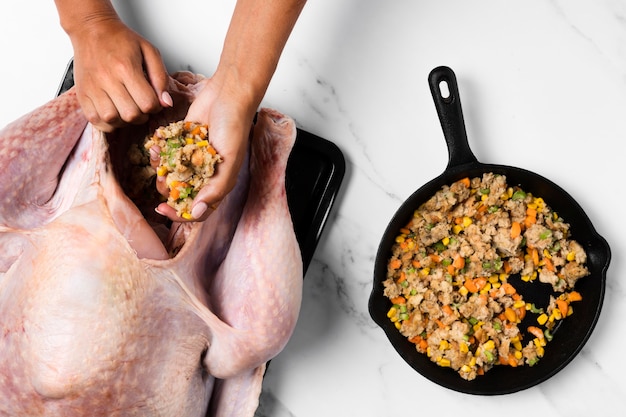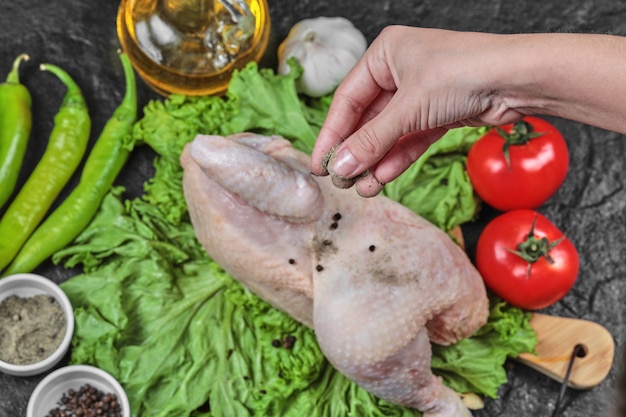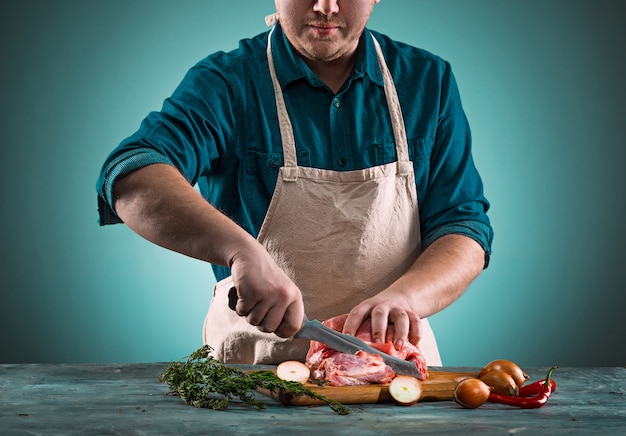Let’s be honest, chuck roast gets a bad rap. Everyone thinks it's tough and chewy. But trust me, that's a misconception! With the right approach, you can transform this humble cut of beef into a culinary masterpiece.
I've been cooking chuck roast for years, and I've learned a thing or two along the way. From slow braising to pressure cooking, there are a multitude of ways to coax out its tender, flavorful potential. It's all about understanding the meat and the process, my friend.
So grab a cuppa, settle in, and let’s embark on this culinary adventure together.
(Part 1) Choosing the Right Chuck Roast

Before you even think about picking up a pan, you need to find the perfect chuck roast. Now, this is a bit subjective, but here’s what I look for:
Size and Shape
I usually go for a 2-3 pound chuck roast. It's a great size for a family meal, and it cooks up beautifully in most ovens. And when it comes to shape, I prefer a roast with good marbling – that’s the streaks of fat throughout the meat. It adds a ton of flavor and keeps the meat incredibly moist during cooking.
Fat Trim
Don’t get too hung up on trimming the fat. Remember, fat equals flavor! Leave a good layer of fat on the roast, but feel free to trim away any excess, especially if it looks like it's too thick.
Seek Out Quality
I always try to buy from a reputable butcher. They'll have a fantastic selection of chuck roasts, and they know their stuff. They can tell you about the cut, where it came from, and recommend the best one for your needs.
Personal Preferences
Everyone has their own preferences, so don't be afraid to ask! Some folks prefer a bone-in chuck roast for a more intense flavor, while others prefer boneless for easier slicing. It's all about what suits you best!
(Part 2) Preparing the Chuck Roast

Now, you’ve got your chuck roast, let's get it ready to shine. Here’s my tried and true method:
Pat Dry and Season
First, pat the chuck roast dry with paper towels. This helps to crisp up the outside during cooking. Next, season it generously with salt and freshly ground black pepper. I love the extra kick that fresh pepper adds.
Add Flavor
You can also introduce other seasonings at this point, but keep it simple. A good garlic rub is always a winner, or a sprinkle of paprika for a touch of warmth. I personally love making my own dry rubs, but feel free to use a pre-made one if you prefer.
Optional Step: Searing
This is a bit controversial, but I find it really boosts the flavor of the chuck roast. I like to sear the roast on all sides in a hot skillet before cooking. It gives it a beautiful, crispy crust and locks in all those delicious juices.
The Bottom Line
The key to a successful chuck roast is to keep it relaxed. You want the meat to feel comfortable, not stressed. So, keep the preparation simple and let the magic happen during the cooking process.
(Part 3) Cooking Methods

Now, let’s get to the good stuff: cooking the chuck roast. Here are a couple of my favorite methods:
Slow Braising
This is my go-to method for chuck roast. It’s slow, it’s steady, and it always delivers tender, melt-in-your-mouth results.
What You’ll Need:
A dutch oven or heavy-bottomed pot
Braising liquid (wine, broth, stock)
Aromatics (onions, garlic, carrots)
How to Do It:
1. Sear the Roast: As mentioned before, I like to sear the roast in a hot skillet before braising. It adds a lovely depth of flavor.
2. Add Aromatics: Sauté the aromatics in the same pot until they’re fragrant and softened. This is where you can add a little bit of creativity – try adding herbs like thyme or rosemary for an extra layer of flavor.
3. Pour in the Braising Liquid: Pour the liquid into the pot, making sure the roast is mostly submerged.
4. Bring to a Simmer: Let the liquid simmer for about 30 minutes, skimming off any foam that forms. This helps keep the braising liquid clear and flavorful.
5. Cover and Cook: Cover the pot tightly and transfer it to a preheated oven. Braise at 325°F for 3-4 hours, or until the meat is incredibly tender. You can check for tenderness by gently poking the roast with a fork – it should easily pierce the meat.
Pressure Cooking
This method is quick, easy, and produces beautifully tender chuck roast in a fraction of the time.
What You’ll Need:
A pressure cooker (instant pot)
Pressure cooking liquid (broth, water)
Aromatics (onions, garlic)
How to Do It:
1. Sear the Roast: Again, I like to sear the roast in a hot skillet before pressure cooking for that extra flavor boost.
2. Add Aromatics: Sauté the aromatics in the pressure cooker until they’re softened.
3. Pour in the Cooking Liquid: Pour the broth or water into the pressure cooker, making sure the roast is mostly submerged.
4. Pressure Cook: Cook the roast under pressure for 90-120 minutes, depending on the size and thickness of the roast.
5. Natural Pressure Release: Let the pressure release naturally for at least 15 minutes. This helps the meat retain moisture and tenderness.
Other Methods
There are other methods for cooking chuck roast, like roasting in the oven or grilling. However, I find that slow braising and pressure cooking consistently deliver the most tender and flavorful results.
(Part 4) Serving Ideas
You've got a beautiful, tender chuck roast - now what? The possibilities are endless! Here are a few serving ideas to get you started:
Classic roast beef
Slice the roast thinly and serve it with roasted vegetables, mashed potatoes, or a Yorkshire pudding. It’s a classic for a reason!
Beef Sandwiches
Shred the roast and pile it onto crusty rolls with your favorite toppings, like horseradish sauce, caramelized onions, or sharp cheddar cheese. Delicious!
Beef Stew
Cut the roast into cubes and use it as the base for a hearty, flavorful beef stew. Add vegetables like carrots, potatoes, and celery for a satisfying meal.
Beef Tacos
Shred the roast and fill soft tortillas with your favorite taco toppings. It’s a fantastic option for a casual weeknight meal.
Beef Dip
Carve the roast thinly and serve it on French bread with a side of au jus for dipping. It’s a fantastic appetizer or a light meal.
(Part 5) Tips for Success
Here are a few tips to help you nail your next chuck roast:
Patience Is Key
Remember, chuck roast is a tough cut of meat. It needs time to break down and become tender. So, be patient and don’t rush the cooking process.
Use a meat thermometer
A meat thermometer is your best friend when cooking chuck roast. It’ll help you ensure that the meat is cooked to the right temperature. Aim for an internal temperature of 190°F for tender, juicy results.
Don’t Overcook It
Chuck roast can dry out if it’s overcooked, so be careful not to let it go too long in the oven or pressure cooker.
Rest the Roast
Before slicing the roast, let it rest for at least 15 minutes. This allows the juices to redistribute throughout the meat, resulting in a more flavorful and tender roast.
Make Ahead
Chuck roast is a great make-ahead meal. You can cook it ahead of time and reheat it before serving. It’s a convenient option for busy weeknights.
Leftover Magic
Don’t throw away those leftovers! You can use them to make delicious sandwiches, salads, soups, or even a hearty pasta dish.
(Part 6) Understanding the Chuck Roast
Let’s take a closer look at the chuck roast itself. It’s a cut of beef that comes from the shoulder of the animal. It’s a tough cut, but it’s also packed with flavor.
Why Is Chuck Roast Tough?
Chuck roast is tough because it’s a muscle that gets a lot of use. It's constantly working, which results in tougher muscle fibers.
The Magic of Collagen
But here's the good news: chuck roast is also rich in collagen, a type of protein that breaks down into gelatin when cooked. This gelatin is what makes the chuck roast tender and juicy!
The Key to Tenderness
To make chuck roast tender, you need to break down those tough muscle fibers. That’s where slow cooking methods come in. They allow the collagen to break down and turn into gelatin.
(Part 7) The Flavor of Chuck Roast
Chuck roast is a flavorful cut of beef, but it needs the right cooking technique to bring out its full potential. Here's how to enhance that flavor:
Marination
Marinating the roast can enhance its flavor. You can use a simple marinade of oil, vinegar, and herbs, or a more complex marinade with soy sauce, honey, and ginger. Experiment and see what you like!
Adding Aromatics
Adding aromatics like onions, garlic, carrots, or celery during cooking can enhance the flavor of the roast. These ingredients add depth and complexity to the dish.
Broth or Wine
Using a flavorful broth or wine for braising or pressure cooking will also add depth of flavor to the roast. I love using a red wine for braising – it gives the roast a wonderful richness.
Flavorful Garnishes
Once the roast is cooked, you can add some finishing touches for extra flavor. You can use a sprinkle of herbs, a drizzle of sauce, or a sprinkle of cheese.
(Part 8) Common Mistakes
Here are some common mistakes people make when cooking chuck roast:
Overcooking
Overcooking chuck roast can make it dry and tough. Make sure you use a meat thermometer to ensure the roast is cooked to the right temperature.
Not Using a Slow Cooking Method
Chuck roast needs time to break down and become tender. Using a slow cooking method like braising or pressure cooking is essential.
Not Resting the Roast
Resting the roast allows the juices to redistribute throughout the meat, resulting in a more flavorful and tender roast.
Not Seasoning Properly
Don’t forget to season your chuck roast generously with salt and pepper. You can also add other seasonings, but don’t go overboard.
(Part 9) FAQs
Q: Can I use any cut of beef for braising?
A: While chuck roast is a classic choice for braising, you can also use other cuts like brisket, short ribs, or even a tougher cut of steak. These cuts are also high in collagen and benefit from slow cooking methods.
Q: What happens if I don’t sear the roast before cooking?
A: Searing the roast isn’t essential, but it does add a nice depth of flavor and creates a crispy crust. If you don’t sear it, you’ll still end up with a flavorful roast, but it might not have that same level of browning and caramelization.
Q: What’s the best way to reheat leftover chuck roast?
A: You can reheat leftover chuck roast in the oven, on the stovetop, or in the microwave. If you’re reheating it in the oven or on the stovetop, make sure to add a little bit of broth or cooking liquid to prevent it from drying out.
Q: What if my chuck roast is still tough after cooking?
A: If your chuck roast is still tough after cooking, it might have been overcooked or it wasn’t cooked long enough. You can try braising it for a little longer or using a pressure cooker to break down the tougher muscle fibers.
Q: Can I use a different kind of liquid for braising or pressure cooking?
A: You can use different liquids for braising or pressure cooking, like beer, wine, or even water. Just be sure to use a liquid that will add flavor to the roast.
(Part 10) Conclusion
There you have it, the ultimate guide to cooking tender and flavorful chuck roast. It's a cut of beef that's often overlooked, but with the right technique, it can be a real star in your kitchen. Remember, it’s all about embracing the slow cooking methods, understanding the meat, and adding your own personal touch. Get creative, experiment, and enjoy the process! You've got this!
Everyone is watching

Prime Rib Roast Cooking Time Chart: Per Pound Guide
Cooking TipsPrime rib roast. Just the name conjures images of lavish dinners, crackling fires, and hearty laughter. It’s ...

How Long to Bake Potatoes in the Oven (Perfect Every Time)
Cooking TipsBaked potatoes are a staple in my kitchen. They're incredibly versatile, delicious, and surprisingly easy to m...

Perfect Rice Every Time: The Ultimate Guide to Cooking Rice
Cooking TipsAs a self-proclaimed foodie, I've always been a bit obsessed with rice. It's the foundation of countless cuisi...

The Ultimate Guide to Cooking Asparagus: Tips, Techniques, and Recipes
Cooking TipsAsparagus. The mere mention of this spring delicacy conjures up images of vibrant green spears, crisp and burs...

Ultimate Guide to Cooking the Perfect Thanksgiving Turkey
Cooking TipsThanksgiving. Just the word conjures up images of overflowing tables laden with delicious food, the scent of r...
